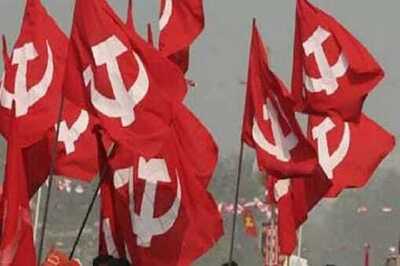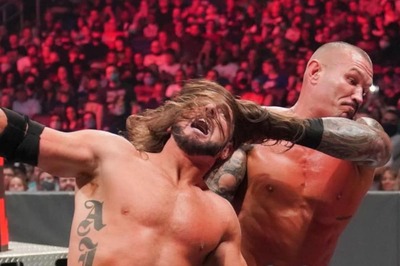
views
Delivering a unanimous verdict, the Supreme Court on Saturday said the underlying structure below the disputed site at Ayodhya was not an Islamic structure, but the ASI has not established whether a temple was demolished to build a mosque.
The observation by a 5-judge Constitution bench, headed by Chief Justice Ranjan Gogoi, was made in its verdict in the politically sensitive case of Ram Janmbhoomi-Babri Masjid land dispute in Ayodhya.
Ahead of the verdict, a lot of arrangements were made to ensure that no untoward incident happens when the verdict is delivered. To ensure security arrangements in Uttar Pradesh, Chief Justice Ranjan Gogoi on Friday held a meeting with the top officials of UP, including its DGP and Chief Secretary.
To tighten the security arrangements in and around Ayodhya, 40 companies or 4000 paramilitary soldiers have been rushed. A close watch on all major religious places across the country is being kept. Railway stations are being closely monitored by RPF which has been put on high alert. And according to the DGP of UP police, nearly 500 people have been pre-emptively arrested.
In Uttar Pradesh, all schools, colleges, educational institutions and training centres have been ordered to remain closed till Monday.
Many factors will go into deciding how the title dispute will be ultimately resolved by the five judge bench headed by the outgoing Chief Justice Ranjan Gogoi, CJI-designate SA Bobde and Justices DY Chandrachud, Ashok Bhushan and S A Nazeer. Let's have a look at them.
Which are the main parties to the dispute?
There are mainly three parties to this dispute. Bhagwan Ram Lalla Virajman, Nirmohi Akhara, and the UP Sunni Wakf Board.
Ram Lalla is led by the Hindu Mahasabha. It represents the deity – baby Ram, whose statue was placed inside the temple, and the janmasthan or the birthplace as juridical persons. They were not a party to the dispute originally and were included in the title suit in 1989 by the Allahabad High Court.
Nirmohi Akhara, an order of Hindu ascetics, claims it has been in possession of the disputed site as its shebait or manager since time immemorial and demand the construction of the Ram temple at the disputed site.
Sunni Waqf board, which controls all the waqf properties throughout the country, wants a mosque to be built on the site. In 1945, a Faizabad judge held that the Babri Masjid is a Sunni property.
How did the dispute begin?
The Hindu litigants claim that ancient texts testify to Lord Ram being born on the banks of the river Sarayu, in Ayodhya, which was identified and where a grand temple was built in his honour. They claim that the Mughal emperor Babur razed this temple in 1528 and built his mosque over it.
The mosque was demolished by Hindu kar sevaks (volunteers) on December 6, 1992. The 2.77 acres of land where the mosque stood is at the centre of the dispute.
The dispute had started around 1857 but it was in 1949 that the idols of Ram and his brother, Laxman, were secretly placed inside the central dome of the mosque. The act itself turned the site into a full-fledged dispute.
Both Hindus and Muslims filed cases disputing each other's claims. From 1950 to around 1961, several suits were filed in court – including ones by present parties Nirmohi Akhara and the Sunni Waqf Board – claiming ownership of the land.
In 1986, Locks of Babri Masjid opened by orders of the district judge of Faizabad and Hindus were granted permission to worship at the site. Three years later, in 1989, Ram Lalla entered the litigation through Deoki Nandan Agarwal, a former judge of the Allahabad High Court and a 'committed' devotee of Lord Ram as a ‘sakha’ or friend.
Subsequently, the then Rajiv Gandhi led government allowed VHP to conduct shilanyas (stone-laying ceremony) on land next to the Babri Masjid. LK Advani 'rath yatra' that started from Somnath in '90 and culminated in Ayodhya, successfully mobilised Hindus for the construction of Ram temple.
How have courts ruled on the matter?
The first big ruling on the title dispute came in September 2010, when the Allahabad High divided the 2.77 acre site equally among the three parties. The Sunni Waqf board, Nirmohi Akhara and Ram Lalla each got a third of the disputed land. The inner courtyard was given to Ram Lalla, the outer Ram Chabutara and Sita Rasoi went to Nirmohi Akhara and the outermost land was allotted to Sunni Waqf board. All the three parties, dissatisfied with the High Court's verdict approached the Supreme Court.
What else has happened in the meantime?
The Supreme Court tried to get the parties to agree to a settlement through a three member mediation panel headed by former Supreme Court Justice FMI Kalifulla, comprising spiritual guru Sri Sri Ravishankar along with senior advocate Sriram Panchu. But the mediation panel failed to develop a consensus among the parties to arrive at an amicable solution.


















Comments
0 comment